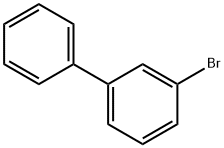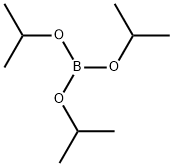
Biphenyl-3-boronic acid synthesis
- Product Name:Biphenyl-3-boronic acid
- CAS Number:5122-95-2
- Molecular formula:C12H11BO2
- Molecular Weight:198.03

2113-57-7

5122-95-2
The general procedure for the synthesis of 3-biphenylboronic acid from 3-bromobiphenyl was as follows: 3.8 g (16 mmol) of 3-bromobiphenyl was added to a 300 mL three-neck flask under nitrogen protection. 100 mL of tetrahydrofuran (THF) was added to dissolve, and the solution was subsequently cooled to -80 °C. Under stirring, 11 mL (18 mmol) of n-butyllithium (1.6 mol/L hexane solution) was slowly added dropwise via syringe. After the dropwise addition was completed, the reaction was kept at -80 °C with continued stirring for 1 hour. Subsequently, 2.2 mL (20 mmol) of trimethyl borate was added to the reaction system and the reaction mixture was allowed to gradually warm up to room temperature with continued stirring for 4 hours. Upon completion of the reaction, the reaction was quenched by the addition of about 50 mL of dilute hydrochloric acid (1.0 mol/L) and stirring was continued for 2 hours. The reaction mixture was transferred to a partition funnel and the aqueous layer was extracted with ethyl acetate. The organic layers were combined and washed sequentially with saturated sodium bicarbonate solution and saturated saline. The organic layer was dried with anhydrous magnesium sulfate and filtered to remove the desiccant. The filtrate was concentrated under reduced pressure to give an oil. Hexane was added to the oily material and a white solid was precipitated. The solid was collected by filtration and dried to give 1.7 g of white powdery 3-biphenylboronic acid in 55% yield.

2113-57-7
413 suppliers
$14.00/1g

5122-95-2
326 suppliers
$9.00/1g
Yield:5122-95-2 55%
Reaction Conditions:
Stage #1:3-bromobiphenyl with n-butyllithium in tetrahydrofuran;hexane at -80; for 1 h;Inert atmosphere;
Stage #2: with Trimethyl borate in tetrahydrofuran;hexane at -80 - 20; for 4 h;
Stage #3: with hydrogenchloride;water in tetrahydrofuran;hexane for 2 h;
Steps:
9.2
Into a 300 mL three-neck flask was put 3.8 g (16 mmol) of 3-bromobiphenyl was put, and the air in the flask was replaced with nitrogen. To the flask was added100 mL of tetrahydrofuran (THF) was added, and this solution was cooled down to -800C. To this solution was added 11 mL (18 mmol) of n-butyllithium (a 1.6 mol/L hexane solution) by being dropped with a syringe. After the dropping was completed, this solution was stirred at the same temperature for 1 hour. After the stir, 2.2 mL (20 mmol) of trimethyl borate was added thereto, and the mixture was stirred for 4 hours while the temperature of the mixture was brought back to a room temperature. After the stir, about 50 mL of dilute hydrochloric acid (1.0 mol/L) was added to the solution, and then the solution was stirred for 2 hours. After stir, the aqueous layer of the mixture was extracted with ethyl acetate and the extracted solution and the organic layer were washed together with a saturated sodium bicarbonate solution and saturated saline. The organic layer was dried with magnesium sulfate, and this mixture was subjected to gravity filtration to obtain a filtrate. The obtained filtrate was concentrated to give an oily substance. Hexane was added to the oily substance, whereby a white solid was precipitated. The obtained solid was collected to give 1.7 g of white powder, which was the object, at a yield of 55%.
References:
SEMICONDUCTOR ENERGY LABORATORY CO., LTD.;SUZUKI, Hiroki;KAWAKAMI, Sachiko;OHSAWA, Nobuharu;SUZUKI, Tsunenori;SEO, Satoshi WO2010/5066, 2010, A1 Location in patent:Page/Page column 178-179

121-43-7
379 suppliers
$13.00/25mL

2113-57-7
413 suppliers
$14.00/1g

5122-95-2
326 suppliers
$9.00/1g

5419-55-6
386 suppliers
$12.00/5g

2113-57-7
413 suppliers
$14.00/1g

5122-95-2
326 suppliers
$9.00/1g

688-74-4
327 suppliers
$10.40/25mL

103068-18-4
36 suppliers
$199.00/50ml

5122-95-2
326 suppliers
$9.00/1g

108-36-1
451 suppliers
$10.00/1g

5122-95-2
326 suppliers
$9.00/1g